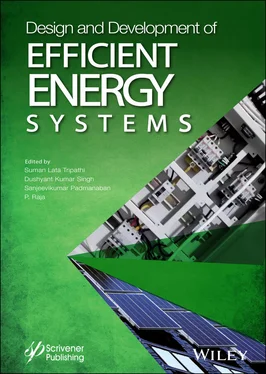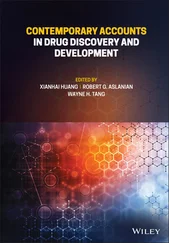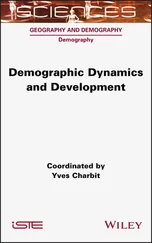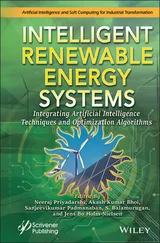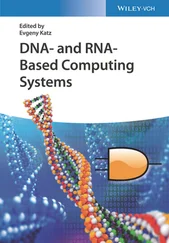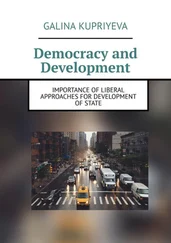8 Chapter 8Figure 8.1 Block diagram of PV-based inverter fed drive.Figure 8.2 Electrical model of Solar cell.Figure 8.3 I-V and P-V characteristics of PV array.Figure 8.4 MATLAB Simulink Model of Single-Phase H Bridge Inverter.Figure 8.5 Simulation Output of Single-Phase H Bridge Inverter.Figure 8.6 MATLAB Simulink Model of Diode Clamped Multi-Level Inverter.Figure 8.7 Five Level Line Voltage Waveform.Figure 8.8 Five Level Phase Voltage Waveform.Figure 8.9 Five level voltage w.r.t. to DC terminal.Figure 8.10 MATLAB Simulink Model of PV powered H Bridge Inverter fed Drive.Figure 8.11 Output Waveforms of PV powered H Bridge Inverter fed Drive.Figure 8.12 MATLAB Simulink Model of PV powered DCMLI fed Drive.Figure 8.13 Output Waveforms of PV powered DCMLI fed Drive.Figure 8.14 MATLAB Simulink Model of PV powered Cascaded H Bridge MLI-fed Drive.Figure 8.15 Subsystem Block of PV powered Cascaded H Bridge MLI-fed Drive.Figure 8.16 Phase voltage waveform.Figure 8.17 Line voltage waveform.
9 Chapter 9Figure 9.1 Existing energy storage system with universal controller.Figure 9.2 Proposed energy storage system with universal controller.Figure 9.3 Overall proposed converter circuit.Figure 9.4 Single-stage rectification.Figure 9.5 Single-stage inversion.Figure 9.6 e-Chopper.Figure 9.7 Mode-1 duty interval.Figure 9.8 Mode-2 free-wheeling interval.Figure 9.9 Double-stage rectification.Figure 9.10 Single-stage rectification output/e-chopper input.Figure 9.11 Double-stage inversion.Figure 9.12 Charging mode.Figure 9.13 Duty mode.Figure 9.14 Inverter mode (power flow from WECS to grid).Figure 9.15 E-chopper control.Figure 9.16 3Ø inverter control system.Figure 9.17 Proposed CB-PWM approach representation by zero-sequence injection.Figure 9.18 Experiment result VL.Figure 9.19 Experiment result of line voltage when V L= 250V.Figure 9.20 Steady state waveform V L= 350V.Figure 9.21 Proposed system dynamic waveform.Figure 9.22 Power loss comparion T-Traditional, P-Proposed.Figure 9.23 THD and harmonic analysis.
10 Chapter 10Figure 10.1 Three sections of energy segment.Figure 10.2 Benefits of IOT in renewable energy sources.Figure 10.3 Chart representing the parts of an IoT stage.Figure 10.4 Different types of sensors for different applications.Figure 10.5 Classic wireless sensor node design.Figure 10.6 An integrated information connectivity in a smart city model.Figure 10.7 Segment of domestic energy intake.Figure 10.8 Claims of Internet of Things within incorporated intelligent vitalit...Figure 10.9 Innovation in energy sector with block chain and IOT.Figure 10.10 Virtual power plant with artificial intelligence and IOT.Figure 10.11 Green energy and Internet of Things as a crucial technology.
11 Chapter 11Figure 11.1 Electricity generated through different renewable energy source in 2...Figure 11.2 Sugar based bio-energy produced and transferred to the grid [45].
12 Chapter 12Figure 12.1 Electrical energy production from various sources (2018 figures).Figure 12.2 Parabolic trough arrangement.Figure 12.3 Dish type collectors.Figure 12.4 Tower type power system.Figure 12.5 Water heating.Figure 12.6 Building using passive heating.Figure 12.7 Use of process heat for buildings.Figure 12.8 Wind turbines.Figure 12.9 Geothermal plant in Iceland.
13 Chapter 13Figure 13.1 Block diagram of the proposed system.Figure 13.2 DAS versus critical growth stages and optimum temperature ( oC) requi...Figure 13.3 Flow chart.Figure 13.4 Plots between (a) Sensor output voltage and sensor analog voltage (b...Figure 13.5 Layout of the sprinkler system.Figure 13.6 Testing system for lab and field.Figure 13.7 Snapshot of (a) Gauges and charts on cloud showing real-time data. (...
14 Chapter 14Figure 14.1 Obaidat et al . Reference architecture for IoT [16].Figure 14.2 Components of IoT [10].Figure 14.3 Vongsingthong et al . hierarchy of user authentication method [6].Figure 14.4 Mahadi et al . Demonstrate the varied machine learning approach [5].Figure 14.5 Various gait operations in proposed method.Figure 15.1 Block diagram.Figure 15.2 NODEMCU ESP8266 Pinouts.Figure 15.3 (a) SW-420 Vibration Sensor, (b) KE-25 Oxygen Sensor, (c) NDIR Carbo...Figure 15.4 System structure.Figure 15.5 Working prototype of the problem with blinking LED.Figure 15.6 LED blinking with the second type sensor.Figure 15.7 (a–d) Measurement of the Temperature and Humidity in four different ...Figure 15.8 Module output associated with the data for temperature and humidity ...
15 Chapter 16Figure 16.1 Publication data for IoT and its challenges.Figure 16.2 IoT Architecture [1].Figure 16.3 Application areas of Internet of Things (IoT) [3].Figure 16.4 Block diagram showing an IoT system.
16 Chapter 17Figure 17.1 Basic Structure of FinFET.Figure 17.2 (a) Ultra-thin body (b) Dual gate.Figure 17.3 (a) Planar double-gate FET (b) 90 orotation DG-MOSFET (c) 90 orotati...Figure 17.4 (a) FinFET (b) Ω -gate MOSFET (c) GAA MOSFET.Figure 17.5 (a) IG-FinFET (b) Shorted Gates.Figure 17.6 Fin width variability.Figure 17.7 14nm FinFET Structure.Figure 17.8 (a) 7T SRAM cell with FinFET (b) 1T DRAM cell with FinFET.Figure 17.9 Side view of FinFET as biosensing cavity region.
17 Chapter 18Figure 18.1 The role of multi-level inverters in a typical Microgrid.Figure 18.2 Suggested 19-level inverter topology.Figure 18.3 Operational modes for producing ±9 Vdc output voltage steps.Figure 18.4 Operational modes for producing ±8 Vdc output voltage steps.Figure 18.5 Operational modes for producing ±7 Vdc output voltage steps.Figure 18.6 Operational modes for producing ±6 Vdc output voltage steps.Figure 18.7 Operational modes for producing ±5 Vdc output voltage steps.Figure 18.8 Operational modes for producing ±4 Vdc output voltage steps.Figure 18.9 Operational modes for producing ±3 Vdc output voltage steps.Figure 18.10 Operational modes for producing ±2 Vdc output voltage steps.Figure 18.11 Operational modes for producing ± Vdc output voltage steps.Figure 18.12 Operational modes for producing zero output voltage step.Figure 18.13 Cascaded configuration of suggested structure.Figure 18.14 Fundamental frequency method.Figure 18.15 Gate pulses for switches of suggested structure.Figure 18.16 Output voltage of suggested topology.Figure 18.17 Number of sources per number of levels.Figure 18.18 Number of capacitors per number of levels.Figure 18.19 Number of semiconductors per number of levels.Figure 18.20 Per-unit total voltage stress per number of levels.Figure 18.21 Cost function per number of levels.Figure 18.22 Output voltage and current waveforms.Figure 18.23 Voltage waveform of C 1-C 4capacitors.Figure 18.24 FFT analysis of suggested topology.Figure 18.25 Voltage stress on switches of suggested topology.
1 Chapter 1 Table 1.1 Comparison of existing MOSFET structures.
2 Chapter 2 Table 2.1 Sutra in Vedic mathematics [2–5]. Table 2.2 FPGA utilization summary report. Table 2.3 Cell area of 8x8 vedic multiplier. Table 2.4 Power constraints of 8x8 vedic multiplier. Table 2.5 Time constraint of 8x8 vedic multiplier. Table 2.6 Cell area of 16x16 vedic multiplier. Table 2.7 Power constraints of 16x16 vedic multiplier. Table 2.8 Time constraint of 16x16 vedic multiplier. Table 2.9 Comparison of multiplier architecture.
3 Chapter 3 Table 3.1 Tristate pattern.
4 Chapter 6Table 6.1 Details of Case Studied Pump.Table 6.2 Major differences between VCR and VAR.Table 6.3 Type of lamps.Table 6.4 BEE star ratings for LED lamps.Table 6.5 LED Luminaire Efficiency Labels of EU (EU 2019/2015) w.e.f 1 stSeptemb...Table 6.6 Star ratings.Table 6.7 Reference outdoor temperature in distribution.Table 6.8 EU energy efficiency ratings.Table 6.9 Induction and BLDC motor fans.Table 6.10 Star Rating of 1200 mm Size Ceiling Fan, 2010.Table 6.11 Underrated operation of a 200 HP, 4 pole motor.Table 6.12 Energy-efficiency ratings of BEE.Table 6.13 Minimum energy performance standards of a 250 KW motor.Table 6.14 Energy-efficiency ratings of IEC.Table 6.15 Transformer population progression.Table 6.16 IEC recommendation (in %).
Читать дальше
